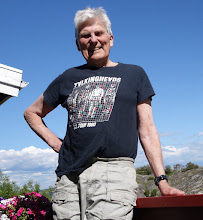We are going to work backwards from today Saturday, 2020-05-30 in The Year of Corona in Sweden. I was up with the sun - remember we are at 58 N Latitude and I drove out to Ullstämma Naturreservat and started running, destination, THE TREE IN THE POND.
The Tree in The Pond, a Salix, died not long after the pond was created in 2011. Still standing after all these years, trees can do that. The text on the hat says Keep Vermont Weird, in the picture because that is where I was supposed to be today 5/30 but am not for well known reasons. The T shirt was chosen because it names the first 10 km race I had ever run in in my life, 10 km along Stångån a river and canal that runs through Linköping. After running I wrote in my 15th Life Book as always.
I find my 15th Life easy to set off from those that preceded it, 14th and back through time. A new disease helped in setting it off against all others, the disease now referred to as COVID 19, the disease that led to cancellation of my Icelandair flight to Boston.
Now I want to take a GIANT LEAP, back to 1967 followed by 1971, with two pictures showing superficially what became the greatest single transformation in my life up to that time and perhaps ever.
1967 from a picture of the Faculty of the Department of Geology, University of Rochester. I had at that time applied for a sabbatical that would take me either to Finland or Sweden. It became Finland where I became Fulbright Lecturer in Geology at Oulun Yliopisto (University of Oulu) then the northernmost university in the world. I was to give lectures on the subject of Mountain (Orogenic) belts since I had been working in one of those for many years starting when I was a doctoral student at Yale.
We four, Marjorie Hay Lundgren, Gary Lundgren, Julie Lundgren, and I were off to Finland on the Oslofjord a couple of months later. We had all learned quite a bit of Finnish and I had also taken an evening course in Swedish, taught by Kjell Westin, who left Sweden when he was 18. The story of how Finland changed my life forever is long and will not be told here but the outcome was that as a result of reading Swedish language newspapers I learned for the first time about chemical contamination of fresh water from fossil-fuel emissions and about the chemical contamination of fish with mercury, processes I had never heard about in the US. We came back to a USA shaken by events of 1968 as a result of the Vietnam War, but also a USA where adverse environmental changes were taking place, completely lost in the background with Vietnam in the foreground. I created a new course, Geology and Public Policy, to introduce that field of research in my department, and strangely I also became head of the River Campus Faculty Senate. Here I am on the steps of some River Campus Building with three students, 1971, but not sure if that was in connection with Dandelion Day or Alternative Graduation. Not sure who the students were, have to ask Scott Brande who gave me the picture quite recently.
Now we take a giant leap back to 1949 when the two of us shown here graduated from East Providence High School and went on to Brown University which at that time had a separate college for women, Pembroke College where my mother also had gone. These two pictures are in part my way of thanking Joan Carmody Theve for making contact a few years ago to remind me that we had grown up in Rumford, RI, in houses 100 yards apart, going through 7 years of school there, a gap when I moved to Seekonk, and again in the same school East Providence High School and then to Brown/Pembroke.

The pictures came from an OnLine copy of the yearbook and my page had been colored but Joan's had not.
The Year of Corona seemed like a good time to start this project. Thanks to Joan, Marie Vacca Halka, Jeff Halka, and Scott Brande, the last 3 all students at the U of R in the 70s and friends for life with Scott the most recent addition.









